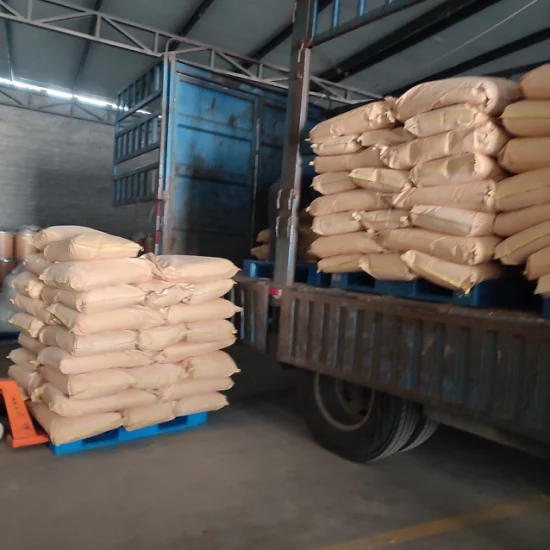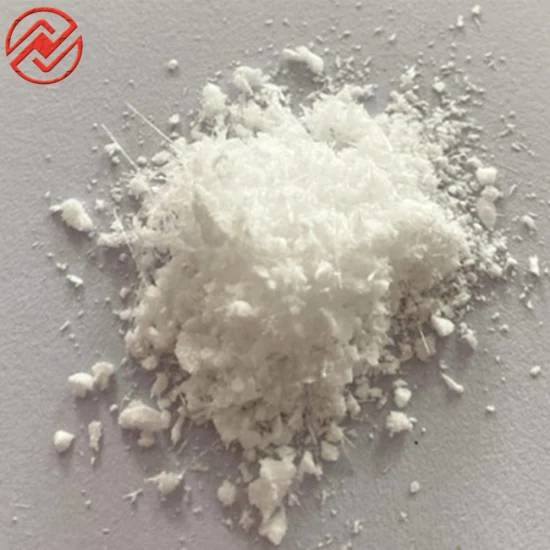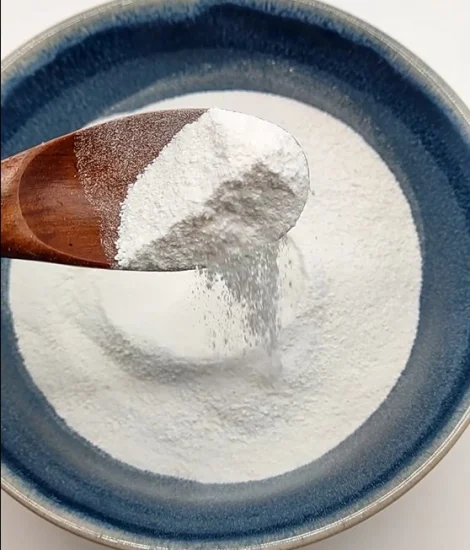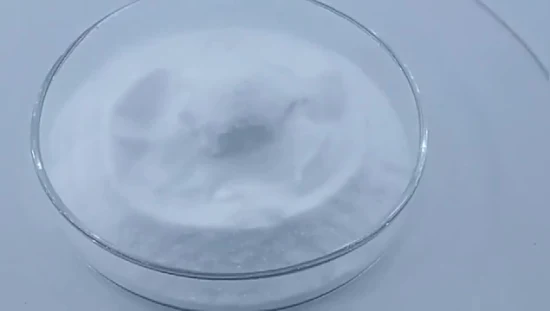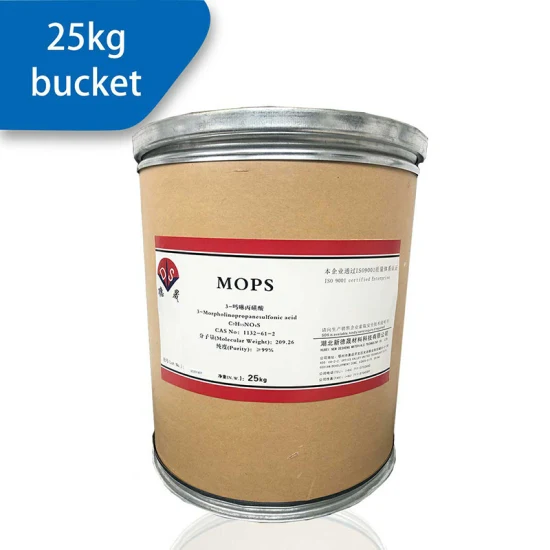
Mops Biological Good′ S Buffer CAS# 1132-61-2
Description
Basic Info
| Model NO. | DS-CP24 |
| CAS No. | 1132-61-2 |
| Formula | C7h15no4s |
| EINECS | 214-478-5 |
| Classification | Biochemical Reagents |
| Grade | AR |
| Specific Usage | For Biological Purpose, For Tissue Medium Purpose, For Microbiological, For Microscopic Purpose |
| Content | Standard |
| Usage | Laboratory Reagents, Analytical Reagents, Diagnostic Reagents, Teaching Reagents |
| Source | Dry Powder |
| Habit Appellation | Fine Chemicals |
| Application | Industry, Scientific Research, Health, Environmental Protection |
| Property | Biochemical Reagent |
| English Name | 3-Morpholinopropane Sulfonic Acid |
| Abbreviation | Mops |
| Molecular Weight | 209.26 |
| Molecular Formula | C7h15no4s |
| Function | pH Adjustment |
| Scope | Good′s Buffers |
| Transport Package | 25kgs Per Drum |
| Specification | Purity-99.5% |
| Trademark | DESHENG |
| Origin | Ezhou, China |
| HS Code | 2934999099 |
| Production Capacity | 50tons/Month |
Product Description
3-morpholinopropane sulfonic acid MOPS Biological Buffer CAS# 1132-61-2(English name)3-Morpholinopropane sulfonic acid
(Chinese name)3-Morpholinopropane sulfonic acid
(Abbreviation)MOPS
(CAS#)1132-61-2
(Molecular weight)209.26
(Molecular formula)C7H15NO4S
(Storage condition)room temperature, away from light and moisture
(Molecular structure)(Application)Mops is a kind of biological buffer, which is often used to prepare RNA electrophoresis buffer.
(Product advantage)The purity is ≥99%, with good water solubility and stable process, which can ensure that the product appearance is pure white crystal powder.MOPS (3-(-morpholino)propanesulfonic acid) is a buffer introduced in the 1960s, one of the twenty Good's buffers. It is a structural analog to MES,[1] and like MES, its structure contains a morpholine ring. HEPES is a similar pH buffering compound that contains a piperazine ring. With a pKa of 7.20, MOPS is an excellent buffer for many biological systems at near-neutral pH.
Applications
MOPS is frequently used as a buffering agent in biology and biochemistry. It has been tested and recommended for polyacrylamide gel electrophoresis.[2] Usage above 20 mM in mammalian cell culture work is not recommended.[3] MOPS buffer solutions become discolored (yellow) over time, but reportedly slight discoloration does not significantly affect the buffering characteristics.[4]MOPS Buffer (10X) (0.2 M, pH 7) Preparation and Recipe
MOPS buffer is often used in polyacrylamide gel electrophoresis. To prepare L of MOPS Buffer (10X) (0.2 M, pH 7):Change the value in the textbox above to scale the recipe volume Table 1. Required components| Component | Amount | Concentration |
| MOPS free acid (mw: 209.26 g/mol) | 41.86 g | 0.2 M |
| Sodium Acetate (mw: 82.03 g/mol) | 4.1 g | 0.05 M |
| Disodium EDTA (mw: 372.24 g/mol) | 3.72 g | 0.01 M |
- Prepare 800 mL of dH2O in a suitable container.
- Add 41.86 g of MOPS free acid to the solution.
- Add 4.1 g of Sodium Acetate to the solution.
- Add 3.72 g of Disodium EDTA to the solution.
- Adjust solution to desired pH using NaOH (typical pH = 7)
- Add dH2O until the volume is 1 L.
MOPS is a zwitterionic biological buffer often used in biological and biochemical research. After reviewing several academic papers in which MOPS buffer was studied, we would like to share with you some recommendations and concerns you must have when using this buffer. We hope you find these tips useful!
MOPS basic information:
- CAS Number: 1132-61-2
- Molecular Weight: 209.3
- Formula: C7H15NO4S
- Useful ph range: 6.5 - 7.9
- pKa (25°C): 7.0 - 7.4
- Price / Specifications: Click here
What is MOPS recommended for?
- For denaturing gel electrophoresis of RNA1
- For protein purification in chromatography
- To measure absorption during UV/VIS spectrophotometry and to study redox properties using cyclic voltammetry2
- In nitrogenase electron transfer mechanism3
- In the separation of nucleic acids and proteins by electrophoresis4
- In the control of culture media pH5, including cell culture media for yeast, bacteria and mammalian cells.
- It has been used as a buffer component of charcoal yeast extract medium6
- It interacts with peptide backbone of bovine serum albumin leading to a net stabilization of the protein7
Which concerns should you have before choosing MOPS for your research?
- MOPS concentration should be not higher than 20mM when used for mammalian cell culture
- Although most studies found little complexation between Mops and metals, some studies found that interferences may occur due to metal complex formation8
- It can modify lipid interactions9
- MOPS can influence the thickness and barrier properties of rat endothelial surface layers10
- It interacts and forms complexes with DNA11
- It can slightly affect mRNA expression of in vitro produced bovine embryos12
- Mops interferes with Lowry protein determination
- It can be oxidized by H2O2, but since buffer oxidation is slow, no significant impact on biological systems is expected to happen13
- MOPS is partly degraded on autoclaving in the presence of glucose
Useful tips about MOPS:
- It does not interfere with Bradford or bicinchoninic acid assays14
Desheng MOPS Buffer
Desheng Biochem is among the largest producers of MOPS in the world. Our products are shipped daily to top research centers and biotech companies in Europe, America and Asia.
What we offer:
- Product straight from our manufacturing sites
- Worldwide shipping to your door
- Assistance with shipping
- Small and bulk packages (from grams to tons)
- International quality standards
- After-sales service with English speaking staff
Prev: Chelate Trace Element Water Soluble Fertilizer
Next: Tris Hydroxylic Acid Raw Material, a High-Purity Biological Buffer Directly Sold by The Manufacturer
Our Contact


